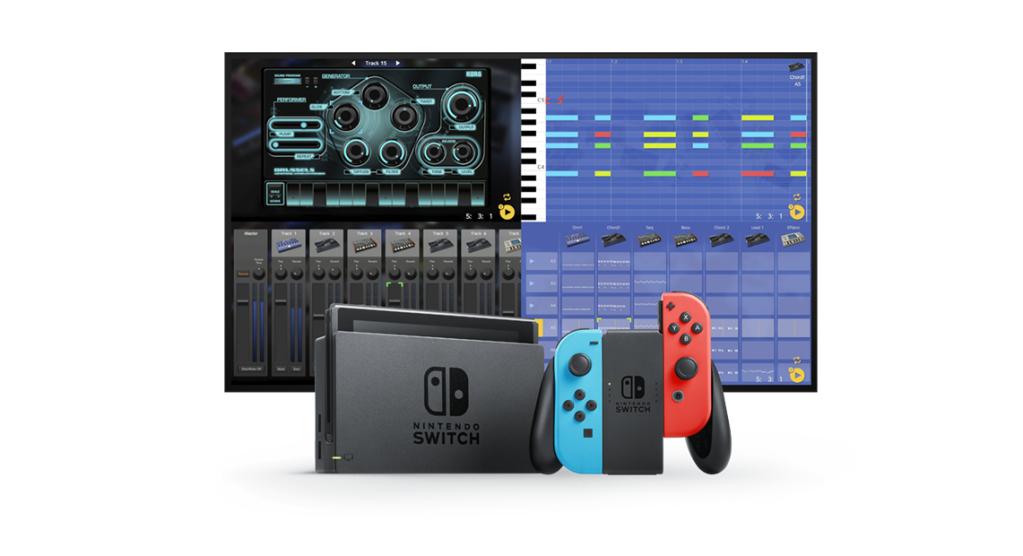In many, many languages, the word for “playing” music is the same as “playing” a game. So it’s fitting KORG has invaded the Nintendo Switch console with music-making – and that you can share with friends.
The translation of KORG Gadget to Nintendo’s Switch handheld is mostly novelty and fun convenience – you’re probably still going to find the iPad version easier to use solo. But where the Switch stands out is some of its multiplayer, collaborative twists. Since on key feature of the Switch (though not Switch Lite) is TV output, you can jam on a large screen or projection image. It’s the old gaming split-screen mode, like in Mario Kart and (back in the day) Goldeneye. Combine that with the “this is just for fun” feeling you get from holding a game console, and you get something you probably wouldn’t get quite so easily with other platforms. This is literally something you might bust out at a party.
The team at online tool Splice decided to give the mode a workout, and produced a video and short blog piece sharing their experiences:
Now, of course, instruments, bands, choirs – all of these provide the same social experience. And none of those things is going away, either, judging by the ongoing market for sheet music, acoustic instruments, accessories, education, and conferences in those fields (really, look it up). So maybe it’s not about production replacing traditional music. Maybe it’s more that we have this new form of musical activity – electronic production – and so far, we haven’t had a good way to share it.
Ever tried to work with a friend in something like Ableton Live? You can easily jam together by adding extra synth gear or drum machines. But using the actual tool Live often means “fighting” over the controls, because both the mouse/keyboard interface and things like Ableton Push tend to assume a single user. (Push will even regularly override other controllers and inputs, but I digress – this isn’t just a Live problem, but a limitation with the computer/user metaphor generally.)
So it seems like a small thing, but even this crude setup shows how you might think about this differently.
More from KORG on Gadget as used for educational purposes, and demonstrating its multiplayer features. (By the way, I was consulted, via New York’s Dubspot, with Rockstar Games on how to make a handheld gaming platform work in music education. The idea has been floating around – but today’s Switch is far better as a choice than the then-current Sony PSP Rockstar was using – sorry, Sony.)
English subtitled, go further into that classroom. I will just assume that in Japan it’s normal for all music teachers to wear lab coats.
Oh, and – another thing. Gaming in general offers an alternative paradigm for how we think about widespread access to music creation, and difficulty level. Not to harp endlessly on Amazon this week, but part of why I was triggered by their keynote was how tired the “everyone can make music without any skill or effort” refrain was.
Gaming has had to tackle this perception, too. But consistently, actual gamers ask for experiences that last. That might be a so-called “casual” game that still sucks up time and ramps up difficulty, or it might be punishing “hard-core” games. But one thing gamers have generally resisted is games that play themselves – which is why the “AI makes music for you” model is so screwed up. (The exception perhaps proves the rule – some mobile games now leverage the data on your usage to essentially squeeze money out of you, leaving the user doing little. Most everyone hates this, and even Apple and Google have had to intervene by changing the underlying business model.)
So back to multiplayer music – Korg GADGET doesn’t take out any of the fundamental work of music production in any other tool. What’s fun about it is making mistakes, screwing up together with other people. And even though theoretically someday this could work online, you can also see in the video that there’s something invaluable about being in the same room together with friends.
I personally think as music production does reach further and further around the world, it’s less and less likely you’ll need to connect online just to find someone else. But of course online multiplayer is there, too, when you want it – still with the large-scale visual feedback of splitscreen. It’s also not hard to imagine that soon the Twitch video streaming phenomenon will grow bigger in music, with some early first indications of crossover already.

Just look for installed base. The iPad is the assumed go-to for this sort of idea, and has its own jam-friendly Ableton Link protocol for just this use case. But iOS has limitations of its own, and it’s clear there are some different ideas possible even where you wouldn’t expect it, on Nintendo Switch.
I think there’s a lesson here for being creative with computing platforms, or even offering devices with video out – people do still own TVs and projectors.
Alternatively, print out this story, stick it in a file folder with your taxes, and tell your accountant that yes, you do need to deduct the cost of a Nintendo Switch. You’ve got just a few shopping days left until the end of the year if you want that to get taken off your tax bill for 2018.
You’re welcome. (Oh, you might want to redact this last bit. Guten Morgen, Finanzamt!)